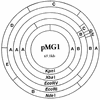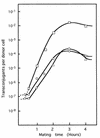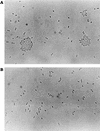Efficient transfer of the pheromone-independent Enterococcus faecium plasmid pMG1 (Gmr) (65.1 kilobases) to Enterococcus strains during broth mating
- PMID: 9733692
- PMCID: PMC107514
- DOI: 10.1128/JB.180.18.4886-4892.1998
Efficient transfer of the pheromone-independent Enterococcus faecium plasmid pMG1 (Gmr) (65.1 kilobases) to Enterococcus strains during broth mating
Abstract
Plasmid pMG1 (65.1 kb) was isolated from a gentamicin-resistant Enterococcus faecium clinical isolate and was found to encode gentamicin resistance. EcoRI restriction of pMG1 produced five fragments, A through E, with molecular sizes of 50.2, 11.5, 2.0, 0.7, and 0.7 kb, respectively. The clockwise order of the fragments was ACDEB. pMG1 transferred at high frequency to Enterococcus strains in broth mating. pMG1 transferred between Enterococcus faecalis strains, between E. faecium strains, and between E. faecium and E. faecalis strains at a frequency of approximately 10(-4) per donor cell after 3 h of mating. The pMG1 transfers were not induced by the exposure of the donor cell to culture filtrates of plasmid-free E. faecalis FA2-2 or an E. faecium strain. Mating aggregates were not observed by the naked eye during broth mating. Small mating aggregates of several cells in the broth matings were observed by microscopy, while no aggregates of donor cells which had been exposed to a culture filtrate of E. faecalis FA2-2 or an E. faecium strain were observed, even by microscopy. pMG1 DNA did not show any homology in Southern hybridization with that of the pheromone-responsive plasmids and broad-host-range plasmids pAMbeta1 and pIP501. These results indicate that there is another efficient transfer system in the conjugative plasmids of Enterococcus and that this system is different from the pheromone-induced transfer system of E. faecalis plasmids.
Figures




Similar articles
-
Possible connection between a widely disseminated conjugative gentamicin resistance (pMG1-like) plasmid and the emergence of vancomycin resistance in Enterococcus faecium.J Clin Microbiol. 2002 Sep;40(9):3326-33. doi: 10.1128/JCM.40.9.3326-3333.2002. J Clin Microbiol. 2002. PMID: 12202574 Free PMC article.
-
Analysis of the conjugal transfer system of the pheromone-independent highly transferable Enterococcus plasmid pMG1: identification of a tra gene (traA) up-regulated during conjugation.J Bacteriol. 2002 Oct;184(20):5800-4. doi: 10.1128/JB.184.20.5800-5804.2002. J Bacteriol. 2002. PMID: 12270839 Free PMC article.
-
Drug resistance of Enterococcus faecium clinical isolates and the conjugative transfer of gentamicin and erythromycin resistance traits.FEMS Microbiol Lett. 2005 Feb 15;243(2):347-54. doi: 10.1016/j.femsle.2004.12.022. FEMS Microbiol Lett. 2005. PMID: 15686834
-
Extrachromosomal and Mobile Elements in Enterococci: Transmission, Maintenance, and Epidemiology.2014 Feb 9. In: Gilmore MS, Clewell DB, Ike Y, Shankar N, editors. Enterococci: From Commensals to Leading Causes of Drug Resistant Infection [Internet]. Boston: Massachusetts Eye and Ear Infirmary; 2014–. 2014 Feb 9. In: Gilmore MS, Clewell DB, Ike Y, Shankar N, editors. Enterococci: From Commensals to Leading Causes of Drug Resistant Infection [Internet]. Boston: Massachusetts Eye and Ear Infirmary; 2014–. PMID: 24649505 Free Books & Documents. Review.
-
The sex pheromone system of Enterococcus faecalis. More than just a plasmid-collection mechanism?Eur J Biochem. 1994 Jun 1;222(2):235-46. doi: 10.1111/j.1432-1033.1994.tb18862.x. Eur J Biochem. 1994. PMID: 8020463 Review.
Cited by
-
Conjugative plasmid transfer in gram-positive bacteria.Microbiol Mol Biol Rev. 2003 Jun;67(2):277-301, table of contents. doi: 10.1128/MMBR.67.2.277-301.2003. Microbiol Mol Biol Rev. 2003. PMID: 12794193 Free PMC article. Review.
-
Identification of Novel Conjugative Plasmids with Multiple Copies of fosB that Confer High-Level Fosfomycin Resistance to Vancomycin-Resistant Enterococci.Front Microbiol. 2017 Aug 15;8:1541. doi: 10.3389/fmicb.2017.01541. eCollection 2017. Front Microbiol. 2017. PMID: 28861056 Free PMC article.
-
Genetic analysis of transfer-related regions of the vancomycin resistance Enterococcus conjugative plasmid pHTbeta: identification of oriT and a putative relaxase gene.J Bacteriol. 2005 Nov;187(22):7727-37. doi: 10.1128/JB.187.22.7727-7737.2005. J Bacteriol. 2005. PMID: 16267297 Free PMC article.
-
Horizontal gene transfer and the genomics of enterococcal antibiotic resistance.Curr Opin Microbiol. 2010 Oct;13(5):632-9. doi: 10.1016/j.mib.2010.08.004. Epub 2010 Sep 15. Curr Opin Microbiol. 2010. PMID: 20837397 Free PMC article. Review.
-
High Incidence of Multiple-Drug-Resistant Pheromone-Responsive Plasmids and Transmissions of VanA-Type Vancomycin-Resistant Enterococcus faecalis between Livestock and Humans in Taiwan.Antibiotics (Basel). 2023 Nov 27;12(12):1668. doi: 10.3390/antibiotics12121668. Antibiotics (Basel). 2023. PMID: 38136702 Free PMC article.
References
-
- Behnke D, Gilmore M S. Location of antibiotic resistance determinants, copy control, and replication functions on the double-selective streptococcal cloning vector pGB301. Mol Gen Genet. 1981;184:115–120. - PubMed
-
- Christie P J, Dunny G M. Identification of regions of the Streptococcus faecalis plasmid pCF-10 that encode antibiotic resistance and pheromone response functions. Plasmid. 1986;15:230–241. - PubMed
-
- Clewell D B. Bacterial sex pheromone-induced plasmid transfer. Cell. 1993;73:9–12. - PubMed
Publication types
MeSH terms
Substances
LinkOut - more resources
Full Text Sources
Molecular Biology Databases
Research Materials

